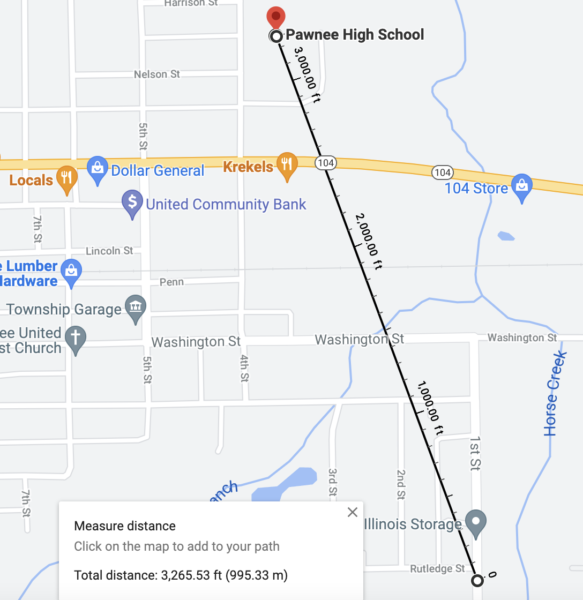Unlike the fictional setting of NBC’s Parks and Recreation (which stars Amy Poehler as Leslie Knope), the small farming community of Pawnee, Illinois, is a very real place. And despite the state’s commitment to 100 percent pollution-free power, Pawnee is facing the very real possibility of a massive new methane gas plant.
Texas-based fossil fuel company EmberClear plans to add a major source of pollution in a town with a population of less than 3,000 ahead of Illinois’ 2045 deadline for power plants to be emission-free.
The Illinois Environmental Protection Agency (EPA) is about to clear the last hurdle for EmberClear to build the proposed Lincoln Land Energy Center, but there is still time for Illinois to say no to new fossil fuels.
A new fossil fuel plant would undermine Illinois’ climate leadership
After three years of building grassroots support and advocating for equitable, ambitious clean energy policies, I hoped that the historic climate legislation the Illinois Legislature passed in September marked the end of fossil fuel companies preying on Illinois communities. But just one month after Gov. J.B. Pritzker signed the Climate and Equitable Jobs Act (CEJA) into law, the Illinois EPA issued a draft air pollution permit to allow EmberClear to build its $1 billion methane gas plant in Pawnee.
This proposed new methane gas plant in central Illinois makes it clear that even with our new, nation-leading climate legislation, our fight against fossil fuel interests is not over.
Thanks to CEJA, Illinois will reach zero emissions from the power sector by 2045. However, fossil fuel interests fought to keep interim emission reduction requirements for some gas plants out of the bill. This created a window for companies like EmberClear to gamble on new gas plants that would operate for only two decades.
Since renewable energy and battery storage are getting cheaper, the $1 billion plant in Pawnee is a risky investment. EmberClear plans for its plant to open in 2025, giving it 20 years to generate profits—and pollution—before the 2045 cutoff date, at the expense of Pawnee residents’ health and safety. But there is no guarantee that the plant would remain economic to run before then, potentially sticking Illinoisans with dirtier and more expensive energy. In fact, a recent analysis by RMI found that 90 percent of proposed combined-cycle gas plants would be uneconomic by 2035 compared to clean energy technologies.
EmberClear is like a prospector, betting that it can make money on this project. No matter what, the company will be putting Pawnee at risk. After all, nobody wants to be left dealing with a pit after a corporation clears out—the way Parks and Recreation characters were when a developer abandoned the town. For a less fictional example, we only have to look to Shelby County, Illinois, where two fossil fuel companies successfully fought to slash the property taxes on their gas plants. Communities were forced to return the tax revenues they were counting on.

Leslie Knope (Amy Poehler) falling into the Pawnee pit left by careless developers in the Parks and Recreation pilot.
Allowing fossil fuel companies to extract wealth by making it harder for Illinois to reach 100 percent carbon-free electricity undermines CEJA. For Illinois to live up to its new role as a climate leader, state agencies such as the Illinois EPA should do everything they can to implement CEJA—including scrutinizing new sources of fossil fuel pollution and becoming a nation-leading agency in the fight against climate change.
Methane gas is a growing climate threat
Contrary to the claims of fossil fuel interests, gas is not low carbon—lower compared to coal, but we cannot afford to replace coal generation with methane gas when the goal is zero. Analysis shows we must reduce gas generation by 2030 to meet emission reduction targets that align with the latest climate science.
In 2020, methane gas plants were responsible for almost half of the entire carbon footprint for the U.S. power sector. Gas generation is also on the rise in Illinois, reaching a record high share of in-state electricity generation in 2020.
The Illinois EPA’s draft permit would allow EmberClear’s facility to release more than 3.9 million metric tons of carbon-equivalent emissions each year. That is the equivalent of roughly twice the impact of un-retiring the three Dallman coal-fired units that recently shut down in Springfield, a huge step backward for a state that just committed to 100 percent carbon-free electricity.
Methane gas pollutes communities
Despite fossil fuel company claims that so-called natural gas is “clean,” burning methane gas is dangerous not only for the climate, but also for public health. Burning methane gas for electricity emits nitrogen oxides (NOx), a key ingredient in ground-level ozone and smog.

The Illinois EPA draft permit’s summary of the potential annual pollution from EmberClear’s proposed Lincoln Land Energy Center.
Living in Chicago, I’ve become familiar with the connection between hot sunny days and bad air quality. When air pollutants such as NOx and particulate matter pollution react with sunlight, the resulting ozone and smog increases the risk of heart and respiratory issues and aggravates conditions such as asthma, putting people at risk—particularly those who are already more vulnerable, including children, the elderly, and outdoor workers. In 2020, there were 21 days when air quality in some parts of Illinois was unhealthy for sensitive groups due to ozone and soot, an increase from 13 days in 2019.
Coal historically caused a much bigger soot problem than gas, but that has changed in Illinois. Harvard researchers found that soot, also known as PM2.5, from burning gas for energy and heat was responsible for as many as 2,100 deaths and as much as $24 million in hidden health costs in 2017. Transitioning away from coal generation has saved thousands of lives, but PM2.5 pollution from gas combustion in Illinois is now a greater public health threat than coal.
To make matters worse, the proposed EmberClear gas plant would be located near a residential area less than a mile from Pawnee High School, forcing nearby Pawnee residents and nearly 300 students to breathe pollution from the nearby plant.

The proposed location of the new gas plant at 15000 Black Diamond Rd. is less than a mile from Pawnee High School.
The goals of CEJA require bold leadership to stand up to fossil fuel interests
CEJA boldly states: “To provide the highest quality of life for the residents of Illinois and to provide for a clean and healthy environment, it is the policy of this State to rapidly transition to 100 percent clean energy by 2050.”
The Illinois EPA should reflect the leadership shown by Gov. Pritzker and the Legislature and reject proposals for new sources of fossil fuel pollution. The state should facilitate the rapid transition to 100 percent clean energy; building a new methane gas plant would only widen the gap between where we are and where we need to go to achieve an equitable, carbon-free energy future.
Make your voice heard
Last month, the Illinois EPA held a three-hour public hearing on the draft permit, where advocates, UCS supporters, and community members expressed concerns about the impacts of EmberClear’s proposal. In addition, UCS supporters and Science Network members have submitted more than 500 public comments so far opposing the permit.

Joyce Blumenshine, member of the Central Illinois Healthy Community Alliance and Illinois Chapter of the Sierra Club, testifies at the November 17 Illinois EPA public hearing. (Photo: Illinois Chapter of the Sierra Club)
There is still time to submit a public comment to the Illinois EPA to help stop EmberClear’s proposed gas plant by midnight on December 17. Use the UCS template to submit a comment here.

